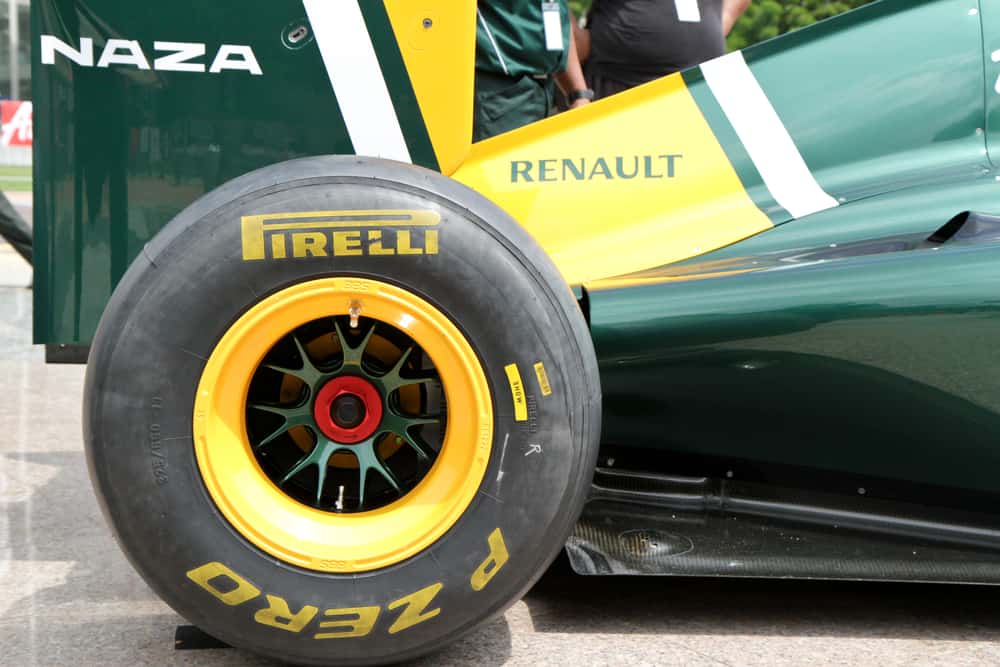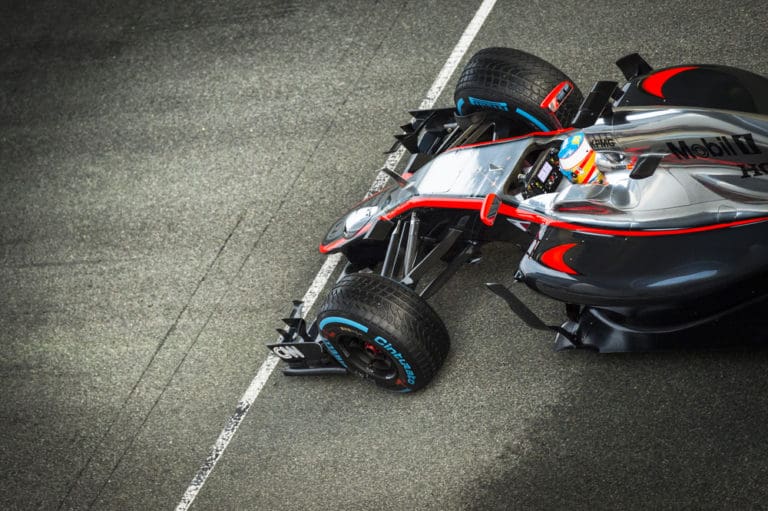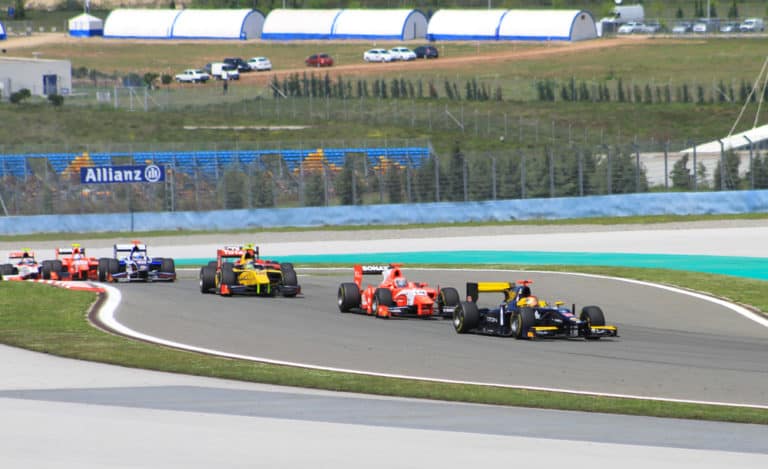The tires on an F1 car are the only part of the car that makes contact with the surface of the racing circuit. For this reason, the tires must be strong and durable enough to last for the whole duration of a Formula 1 race. You may be wondering whether F1 tires can be reused.
F1 tires for an F1 car are only designed to be used for one stint of an F1 Grand Prix and cannot be reused after that. Once a tire wears out, the tire wear starts affecting the car’s performance and consequently causes the car to lose grip on the track causing the car to slow down tremendously.
Let’s explore further to learn how these tires are manufactured and their conditions.
If you’re looking for some F1 merchandise, check out the awesome stuff at the official F1 store here.
How Many Times Can Tires In F1 Be Changed?
Before we understand how many times you can change F1 tires, it is first necessary to understand tire wear. Tire wear can be affected by several factors such as temperature, pressure, weather conditions, and additionally track surface. Even the driver’s driving style can affect tire wear on an F1 car.
How these tires react to the tarmac is crucial to how much grip they deliver. And that is something which teams have an input into, choosing the correct tire compound that will deliver the best grip for the car.
The amount of grip these tires deliver is the critical factor that affects lap times, and of course, if race engineers get it wrong, it will negatively impact lap times.
While a road car’s tires might be expected to last 100,000 kilometers, Formula 1 tires are designed for one stint of a Grand Prix and only for a few laps. Formula 1 tires are built to last for only 50 miles, about the entire length of one Grand Prix circuit.
Depending on the race conditions on the race day, some F1 cars only change tires once during the length of a race.
It becomes even more tricky in wet weather conditions, sometimes requiring a driver to pit and change tires several times as the track conditions and weather conditions change. On a rainy day with a wet track, Wets and Intermediates are used.
In addition, if the tracks are built to be for faster races, then there would be significantly more tire wear, which would require the tires to be changed between two to three times during the race.
Slower circuits would require the harder compound of the tire to be used. Therefore, the tire wear on harder compound tires would be minor compared to a softer compound tire and last a little longer.
F1 cars running on the harder compound tire do not need to change tires often during an F1 race unless a tire blowout or debris causes a puncture on the racetrack.
What Are F1 Tires Made Of?
Most people would assume that tires for an F1 car are made from rubber. But they are not just rubber anymore. The construction of an F1 tire is made up of synthetic materials with only 10% of natural rubber.
The F1 tire is made up of a few composite materials that are based on chemical compounds, namely, Polyisoprene, Poly (Styrene-Butadiene), Polybutadiene, Poly (Isoprene-Isobutylene), and Silica (Reinforcing Filler), and Carbon Black.
There are also four different compounds of slick tires used for dry weather conditions. These are used on different tracks and different circuit conditions. The four different types of dry weather tires are;
- Super Soft
- Soft
- Medium
- Hard
The teams have no control over the weather, and subsequently, they have to pick the right tire for the right conditions on the track.
There are two different types of wet tires, with each tire having slightly different grooves within each tire. The tire profile of a wet weather tire is designed to increase the resistance to aquaplaning, which allows for more grip on the tire in extremely wet conditions. The wet weather tire’s diameter is about 10 millimeters wider than a slick tire.
The new extreme wet tire disperses about 65 liters of water per second as the cars go around the track.
Since 2007, the Formula 1 governing body has contracted one supplier for tires, Pirelli.
Pirelli supplies the five different specifications of the dry weather slick tires, namely C1, C2, C3, C4, and C5, of which only three compounds are used at every race, soft, medium, and hard.
Every compound of the tire is color-coded with a painted band around the outside of the tire wall, along with the supplier’s logo. The tire markings are red for a soft tire, yellow for a medium tire, white for a hard tire, green for the intermediate tire, and blue markings for the extreme wet weather tire.
Formula 1 teams are only permitted a limited number of tire sets for a race weekend: thirteen dry tires, four intermediate tires, and three wet weather tires. Each tire should be marked with a unique identifier for tracking and inspection during the race weekend.
One set of the softest tire is kept aside for the third qualifying session, Q3, and two sets of medium tires and hard tires are kept back for the race.
During a practice session, drivers are permitted to use three sets of slick tires, and some sets of these tires must be sent back to the supplier before the second and third practice sessions.
If drivers are qualifying and racing on slick tires, those who completed Q3 (the top ten qualifying drivers) need to start the race on the same set of tires in which they set their quickest lap time for the session. The cars that qualified outside the top ten can start the race on any leftover set of tires.

How Does The Pit Crew Change Tires?
Every second counts in a Formula 1 race, so when a driver goes in for a pit stop, all the pressure is on the pit crew to get the car and driver onto the track as quickly as possible.
When a driver goes into the pits, all four of his tires are changed at one go, and race engineers cannot afford to get it wrong.
Pit stops can sometimes be longer than expected depending on whether additional parts of the car need changing, such as a front wing or a wheel nut that has not been fixed properly.
Pit stop times can increase in length when there is a puncture or if debris has lodged itself into some part of the car that needs to be removed. Sometimes longer pit stops could be detrimental for the driver as he loses valuable time for every second he is not on the track fighting against his opponent.
For each tire on the race car, there are three mechanics. One mechanic that operates the wheel gun, one mechanic to remove the tire, and one to fit a new tire back onto the wheel hub.
On the four corners of the car, each mechanic will have two pneumatic wheel guns while in the pit. One pneumatic wheel gun serves as a backup in the case of a failure with the primary wheel gun.
The wheel guns operate on compressed air, and it is a highly sophisticated design that has evolved over the years.
There is no concrete limit for the number of times that the tires on an F1 car are changed, as this varies per track and depends on track and weather conditions. Conventionally, if track and weather conditions are ideal, a driver would change tires between two to three times in the duration of a race on a dry track.
It also would depend on the type of tire that is fitted onto the car as well. If the car uses a soft compound tire, the tire wear would be significant, requiring the driver to change tires to either a medium compound tire or a harder compound tire.
Conclusion
The tires on an F1 car have become more sophisticated as the cars evolve. Many new developments in tire technology have recently made tires a lot safer and more durable for F1 cars, which has resulted in better grip and handling on F1 cars.
The current spec of a Formula 1 tire is a 13inch high-profile wheel; however, that specification is soon to change for the new 2022 regulation, as the 18inch low-profile wheel makes its way onto the racetrack and onto the cars.
It will be interesting to see how the change in wheel diameter will change the face of Formula 1 as we know it!
References
- https://en.wikipedia.org/wiki/Formula_One_tyres
- http://www.formula1-dictionary.net/tire_compound.html
- https://www.carthrottle.com/post/all-you-need-to-know-about-a-formula-1-pit-stop/
- https://www.mclaren.com/racing/f1-playbook/graining/
- https://www.essentiallysports.com/f1-news-why-do-pirelli-f1-tires-wear-so-fast/






